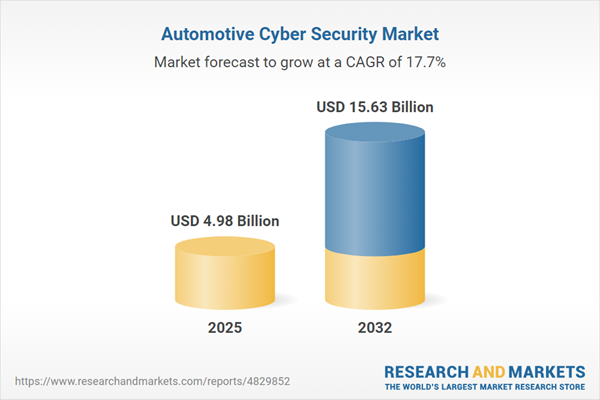Speak directly to the analyst to clarify any post sales queries you may have.
Automotive cyber security has become central to board-level strategies as digital transformation accelerates across mobility, manufacturing, and fleet environments. Senior decision-makers now prioritize systematic risk mitigation to safeguard connected assets and respond to intensifying regulatory, operational, and reputational pressures.
Market Snapshot: Automotive Cyber Security Market Size and Growth
The global automotive cyber security market is forecast to reach USD 4.98 billion in 2025, increasing from USD 4.23 billion in 2024, at a compound annual growth rate of 17.73%. Market projections indicate the sector will exceed USD 15 billion by 2032. Expansion is driven by ongoing integration of connected vehicle platforms, innovative autonomous driving initiatives, and advancing digitization within manufacturing and fleet ecosystems. Organizations are deepening investments in risk management, regulatory compliance, and data security, as these capabilities underpin operational stability, customer trust, and performance continuity.
Scope & Segmentation in Automotive Cyber Security
- Vehicle Types: Passenger cars, commercial trucks, buses, and vans each face distinct cyber threats and compliance requirements. Automotive OEMs, fleet operators, and service partners benefit from tailored threat protection strategies.
- Security Approaches: Critical techniques include encrypted code signing, identity management, endpoint security, network firewalls, and integrated defense mechanisms to achieve end-to-end coverage throughout the vehicle lifecycle.
- Deployment Modes: On-board and off-board—encompassing both cloud and edge—solutions enable continuous monitoring, lifecycle risk management, and coordinated responses spanning manufacturing through active vehicle deployment.
- Component Types: Secure hardware roots of trust, validated boot systems, real-time system monitoring, and adaptive security software are essential for compliance and reliability as connectivity expands across platforms.
- End Users: Key stakeholders include OEMs, public and private fleet managers, logistics providers, and aftermarket service teams, each demanding robust data protection at every stage of the automotive value chain.
- Regional Coverage: Cyber security frameworks must be adapted to unique local regulations, data protection laws, and supply chain dynamics across Americas, EMEA, and Asia-Pacific regions.
- Key Companies Profiled: Industry leaders such as Continental Aktiengesellschaft, Robert Bosch GmbH, Aptiv PLC, Harman International, Elektrobit GmbH, NXP Semiconductors N.V., Infineon Technologies AG, Qualcomm Incorporated, Karamba Security Ltd., and Upstream Security Ltd. set the pace for technology adoption and solutions innovation.
Key Takeaways for Senior Decision-Makers
- Integrated security frameworks provide a holistic approach to vulnerability management, supporting cross-functional alignment of technology and governance standards in vehicle operations.
- Continuous assessment of supplier networks is essential to maintain data integrity and compliance across globally distributed production and service channels.
- Combining hardware-level security with zero-trust architectures strengthens organizational resilience against increasingly advanced cyber threats.
- Adopting widely accepted security protocols streamlines incident detection and response, enabling effective management in distributed fleet and manufacturing settings.
- Versatile security platforms support adaptation to shifting regional regulatory requirements and accelerate deployment of new protection solutions.
- Comprehensive continuity planning ensures preparedness against disruptions, contributing to enterprise stability for transit and logistics operations as cyber risks increase.
Tariff Impact: Evolving Supply Chains and Cost Structures
Forthcoming US tariffs in 2025 are prompting sector leaders to revisit and update cyber security strategies, with an emphasis on enhancing supply chain resilience. Strategic actions include diversifying suppliers, exploring nearshoring, and reinforcing local data governance protocols. These initiatives help organizations comply with emerging privacy laws, respond to shifting regulatory standards, and remain agile as global trade dynamics change.
Methodology & Data Sources
This report synthesizes executive interviews, technical audits, regulatory reviews, and proprietary market datasets to deliver actionable intelligence. The methodology ensures that insights are directly relevant for guiding strategic decisions amidst an evolving automotive cyber security landscape.
Why This Report Matters for Automotive Cyber Security
- Supports senior executives in aligning enterprise operations with the latest risk management, regulatory, and compliance frameworks in connected vehicle ecosystems.
- Guides OEMs, technology integrators, and fleet leaders toward scalable solutions that facilitate digital transformation and safeguard organizational objectives.
- Enables proactive responses to cyber risks across system design and network management, bolstering business continuity and adaptability in complex environments.
Conclusion
Sustaining robust automotive cyber security is foundational for industry credibility and ongoing stakeholder confidence. Cross-organizational collaboration and continual adaptation remain critical as automotive technologies and security challenges evolve.
Additional Product Information:
- Purchase of this report includes 1 year online access with quarterly updates.
- This report can be updated on request. Please contact our Customer Experience team using the Ask a Question widget on our website.
Table of Contents
3. Executive Summary
4. Market Overview
7. Cumulative Impact of Artificial Intelligence 2025
Companies Mentioned
The companies profiled in this Automotive Cyber Security market report include:- Continental Aktiengesellschaft
- Robert Bosch GmbH
- Aptiv PLC
- Harman International Industries, Incorporated
- Elektrobit GmbH
- NXP Semiconductors N.V.
- Infineon Technologies AG
- Qualcomm Incorporated
- Karamba Security Ltd.
- Upstream Security Ltd.
Table Information
| Report Attribute | Details |
|---|---|
| No. of Pages | 184 |
| Published | November 2025 |
| Forecast Period | 2025 - 2032 |
| Estimated Market Value ( USD | $ 4.98 Billion |
| Forecasted Market Value ( USD | $ 15.63 Billion |
| Compound Annual Growth Rate | 17.7% |
| Regions Covered | Global |
| No. of Companies Mentioned | 11 |









